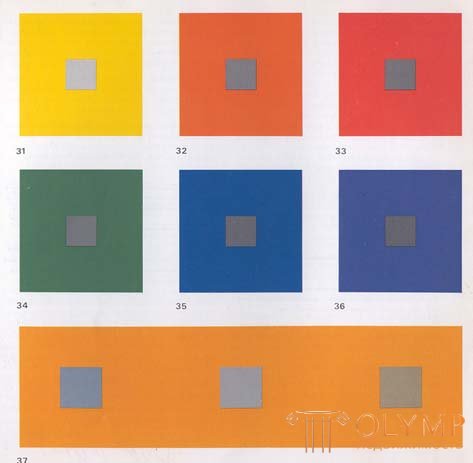
The concept of "simultaneous contrast" means a phenomenon in which our eyes, when they perceive a color, immediately require the appearance of its additional color, and if there is no such color, it simultaneously, that is, simultaneously creates it itself. This fact means that the basic law of color harmony is based on the law of complementary colors. Simultaneously generated colors arise only as a sensation and objectively do not exist. They can not be photographed. Simultaneous contrast, as well as consistent contrast, is most likely to occur for the same reason.
You can put the following experience: on a large, brightly colored plane to place a small black square, and then put a piece of tissue paper on top. If this plane is colored red, then a black square will appear greenish, if it is green, then a black square will appear reddish, on a purple background - yellowish, and if you place it in yellow, then a black square will seem purple-gray. Each color in the eyes of the viewer simultaneously generates its opposite color.

Figures 31-36 demonstrate this experience in a slightly different way. In each of the six squares, painted in pure colors, placed on a small square of neutral gray color, the lightness of which corresponds to the lightness of the primary colors. And immediately, each of these gray squares begins to acquire a shade of color that is complementary to the base color of the large square. Conducting this experience and observing the change in the shade of gray in one or another color square, it should be warned that all other squares should be covered, and the sheet on which they are located is close to the eyes. Simultaneous action will be the stronger, the more active the main color and the longer we look at it.
Since the colors that occur simultaneously do not really exist, but appear only in the eyes, they cause in us a feeling of excitement and lively vibration from the constantly changing intensity of these color sensations. With a long examination, the main color loses its power, the eye gets tired, while the perception of the color that has simultaneously arisen increases.
Simultaneous contrast occurs not only with a combination of gray and any pure chromatic color, but also with a combination of two pure colors that are not strictly complementary. Each of these colors will tend to move the other in the direction of its complementary, and in most cases both colors lose something of their inherent nature and acquire new shades. Under these conditions, colors get the most dynamic activity. Their stability is broken, and they come into a state of changeable vibration. The colors lose their objective character inherent in them and “swing”, as it were, moving from their reality to a new unreal dimension. Color begins to lose its materiality, and the words that "the essence of color is not always identical to its effect", here fully justify themselves.
Simultaneous color properties are of paramount importance to all who work with it. Goethe said that "simultaneous contrast is the primary quality of color, making it possible to use it for aesthetic purposes."
In Figure 37, three small gray squares are shown on an orange background, showing three subtle shades of gray. The reason for the differences in these three gray colors is that a little blue was mixed into the first gray, which contributed to the appearance of simultaneous contrast; the second gray is neutral and subject to simultaneous changes. The third gray contains an admixture of orange color, sufficient to destroy a simultaneous action, as a result of which this gray does not cause any simultaneous changes. This experience shows that with the help of appropriate measures the effect of simultaneous contrast can be enhanced or destroyed.
It is important for an artist to know under what conditions simultaneous effects of color occur and how they can be avoided. There are many color problems in which simultaneous contrasts are undesirable. A few years ago, my visitor, the director of a weaving mill that produces textiles for ties, in desperation turned my attention to several hundred meters of expensive tie silk, which were not sold because the black band on a red background seemed not black, but green, caused a feeling of restless vibration.
The impression this fabric produced was so strong that customers claimed that the yarn was green. If for the production of this fabric instead of a blue-black yarn a brownish-black yarn was used, then the effect of simultaneous contrast would be neutralized, and there would be no material losses.
In addition to the visual possibilities of neutralizing the action of simultaneous contrast, there is still a second opportunity to use colors in varying degrees of lightness. With a contrast of light and dark, the possibility of a simultaneous contrast is reduced. Before starting work on the composition, it is advisable to check the effect of color relationships in the sketch.
Simultaneous manifestations of pure colors occur even when, instead of complementary colors of the twelve-part color wheel, colors are taken that are located to the right or left of the selected initial color. So you can take not yellow to violet, but yellow to red-violet or blue-violet. Since yellow both in red-violet and blue-violet always reveals an additional violet color, red-violet in yellow emphasizes yellow-green, and blue-violet in yellow - yellow-orange, due to which simultaneous vibrations occur. Or another example: if the composition is built of yellow and red on blue, then it is harmoniously calm. If, instead of blue, to take blue-green, then this will immediately lead to a simultaneous game, because red and yellow will be simultaneously excited and will manifest themselves quite differently than on blue.
If it is necessary to enhance the effect of simultaneous contrast, the saturation contrast gives new possibilities here.
As examples of using simultaneous contrast, the following works can be given:
Что бы оставить комментарий войдите
Комментарии (0)